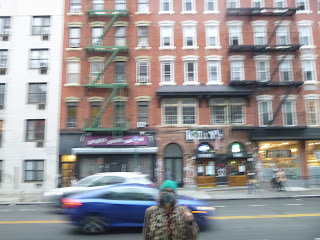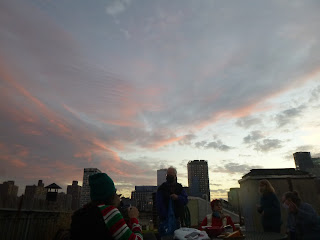Gia Lisa Krahne, at East 39th St, writes:
It happens in the streets.
You see it on the subways.
People go to hospitals to recover from it or try to talk it through.
We try to understand how to cope with it in our classroom.
Trauma Informed practice was one of the most intense teaching experiences of my life.
And that was before the pandemic, that had taken some 300,000 lives in the US alone, while many denied its impacts.
We sat in a circle and taught each other, telling stories, sharing, unpacking our reactions to the secret history of trauma, self-inflicted harm, PTSD, racism, news reports of kids in cages, separated from parents at the border, etc. for 15 weeks,
And then came COVID.
This fall, we did it online, along with my policy practice and field practicum classes.
Each week brought a different set of dynamics.
Each of us sitting at home, students in intergenerational households with their abuelas on one side of the room, their kids on the other, they did their best to participate, as the pandemic ebbed and flowed, each of us losing connections and regaining bandwidth as we all learned online together.
Week in, week out, they report details of their efforts volunteering in hospital, completing internships in hospitals as case rates soared. I read their logs and we try to make sense of it all.
Each day a new story, a friend from high school murdered by her boyfriend, a dead father a student was taking care of, a pregnancy, a zoom funeral, students arriving late or disappearing unable to keep track of online assignments; others coping as they take care of their own families, giving presentations as they wait for covid results, in between shifts at work.
Coping with grief, many struggle concentrate.
Others drop out.
And still others support each other.
This was the case during the trauma and policy presentations - on the McKinley- -Vento Homelessness Assistance Act, Child Abuse Prevention and Treatment Act, the Community Reinvestment Act, or the Violence Against
Women Act, a part of the Violent Crime Control Act and Law Enforcement Act of 1994, one after another, students teaching each other, sharing their understandings.
And then the research case studies in trauma informed practice, integrating Herman’s recovery model of safety, remembering and reconnecting.
More than anything these stories gripped me.
M told the story of her father’s untimely death at the hands of violence in the construction industry and the impact it had on her. Chemical dependency followed. She ending up blacked out in bars in Harlem. Get some therapy, someone told her. Finally, she responded and got some help to talk it out, relating these experiences as lessons she brings from to her practice.
K told the story of her mother in the killing fields of Cambodia, the ways survivors share stories, creating meaning in their shared narratives of survival.
“During the time of Pol Pot, where did it start for you?” she tells the class, recalling the ways survivors of the Cambodian Genocide tell stories of the experiences with the Khmer Rouge, the Communist Party of Kampuchea, reveling in their own survival, eluding a most random and cruel of times, without truth or reconciliation, just multiple narratives helping them cope and find meaning.
She relates little of the intergenerational trauma often witnessed among children of survivors, although her mother does remind her.
"See what we what through, "her mother tells her as she watches the Killing Fields.
Like Spiegelman, she makes sense of it through the stories.
Dith Pran, another survivor, wrote in his journal, while in jail:
Before his death, Pran suggested the stories, the remembering had to continue:
The remembering and reconnecting which characterize recovery take shape in countless forms.
Other students tell stories about immigration policies separating families and mass incarnation or abuse they endured.
The patterns are many.
S tells the story of Gwen Araujo, a trans woman, murdered.
She had no idea how common such occurrences had become.
I keep thinking about her story as I look at the homophobic post it on the F train.
Another talks about how she wants marriage equality for her queer friends; another student recalls her young Black son asking her why George Floyd was killed.
She didn’t know how to tell him.
“For healing to happen, we have to acknowledge this,” says this student, referring to the lingering wound of institutional racism in the country.
Finishing her presentation, we talk the pattern of deaths that never quite seem to slow, of Casey Goodson, an unarmed Black man who was shot by the police the previous Friday. The police said they thought his sandwich was a gun.
Everyone has their memories.
I remember the 99 bullets the police unloaded on Adadou Diallo, a 23-year-old Guinean immigrant, killed in 1999.
“It’s a wallet, not a gun, police misconduct 101,” we chanted after the the four officers responsible for his death were found "not guilty."
We began the class watching the story of the Black Panthers.
And spent the rest of the semester connecting the dots between these stories and trauma theory. The body keeps the score.
Each students checks out at a certain point.
And then they come back.
Why do people self injure or hurt themselves?
What happens when the blues or the blue demon grabs you? What do you do? Do you greet it?
How do we find meaning in it?
How do we let it move through us?
They comment on Bohmian poet Rainer Maria Rilke, who writes: “Be patienttoward all that is unsolved in your heart and try to love the questions themselves, like locked rooms and like books that are now written in a very foreign tongue. Do not now seek the answers, which cannot be given you because you would not be able to live them. And the point is, to live everything. Live the questions now. Perhaps you will then gradually, without noticing it, live along some distant day into the answer….... love your solitude and try to sing out with the pain it causes you. For those who are near you are far away... and this shows that the space around you is beginning to grow vast.... be happy about your growth…”
“Let everything happen to you
Beauty and terror
Just keep goin
No feeling is final...”
***
By Friday, the Ditchdigger was back in town. We walked along the Gowanus, watching the dredging, making our way back to Hoyt, up Pacific Street, along Smith Street, talking about Sentimental Education, spirits flying, moods ebbing, flowing.
"That's a sight that rarely gets into the papers," he notes, pointing at the kids of all backgrounds playing in the playground.
And then the conversation turns to Sentimental Education and Frederic had a similar sort of evening.
"After liquors they drank beer; after the beer, punch, and they filled their pipes time and again. Finally, at five in the evening, they all went off; they were walking along side by side, silence, when Dussardier remarked that Frederic had been a perfect host.
Everybody agreed."
Yet the fellow feeling did not continue, everyone taking the piss.
"Frederic was left on his own. Thinking about his friends, he felt they were great, a dark gulf separating him from them. Yet, he had held his hand out to them. If was they who had responded to his generous gesture."
Friends grow apart. They fight. Sometimes they don't offer what they need.
"... there hung like a fog in his conscience, the awareness of his cowardly behavior to his friend.
Tears choked him...
Deslauriers was hurrying down the Rue des Martyrs.
His friendship for Fred was dead...."
I worried for Fred, Deslauriers and the Ditchdigger.
The next morning, the feeling lingered.
C and I walked through the East Village, along Bond, to Dashwood Books, looking at art books, stores closed, past the smoldering Middle Collegiate Church, the Gothic Revival church in the neighborhood since 1892.
Jim Eigo was making his way back to Tompkins Square Park, where he jotted some notes on the scene:
"Not long before the pandemic shut the city down in March, I spent an evening there in a neighborhood expression of solidarity with immigrants. It’s the kind church where even a not-quite-believer like me could spend a couple of hours & not feel too uncomfortable. I shot these pics today from 7th St. The fire started due to faulty wiring in the building north of the church that once stood on the corner of 7th & 2nd; now reduced to rubble, it has mostly been hauled away. South of the Church, & much less damaged, is the home of the Women’s Prison Association, dedicated to improving the lives of women impacted by incarceration since the 1840s. The gutted church still has two partial walls standing, its skeletal façade still flanked by a short & tall tower. Though the church only dates from the 1890s, for many years its bell tower has housed the New York Liberty Bell, which rang at the 1st public reading of the Declaration of Independence in the city on July 9, 1776. Last I read, it had yet to be determined if the bell had been damaged. What a year 2020 has been."
C and I snapped a few shots and made own way down St Marks Place, back to Hanoi House, on St Mark's Place, for for Bia Hoi and Pho, with cilantro, rice noodles, onions and scallion.
Down Ave A. we walked, past her father's old apartment, that he passed on to Debbie some five decades prior, down to Christine's, for hot cider and whisky on the roof, as the sun went down, friends from decades of salons and meetings, collectives long gone, Lower East Side Collective, Right of Way, Public Space Party.
I was thinking about the fissure between Deslauriers and Freddie and the Ditchdigger.
Flaubert agonized writing about them and Madan Bovary.
"She wanted to die. She also wanted to live in Paris."
God knows, don't we all.
Sunday, we walked to Red Hook to Luis Valentino Pier, past the Gatos and graffiti that seemed to speak to us, dead fish on the beach as the boats made their way along the water.
"If anyone needs a laugh, its the truly deeply fucked," says Susie on Marvelous Mrs Maisel, another term coming to an end.
The teenager's favorite show - getting us all through an odd year.


































































































This comment has been removed by a blog administrator.
ReplyDeleteThis comment has been removed by a blog administrator.
ReplyDelete